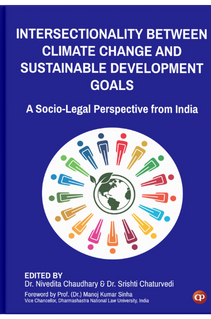Regulating Energy Transition in India: Understanding the Challenges

by Dr. Yogendra Kumar Srivastava1 & Dr. Amitesh Deshmukh2
1Professor of Law and Dean – Post-Graduate Studies, Hidayatullah National Law University, Raipur, India; 2Assistant Professor of Law, Hidayatullah National Law University, Raipur, India.
10.46679/9788196780524ch12
This chapter is a part of: Intersectionality Between Climate Change and Sustainable Development Goals: A Socio-Legal Perspective from India
ISBN (Ebook):978-81-967805-2-4
ISBN (Hardcover Print):978-81-967805-0-0
ISBN (Softcover Print):978-81-967805-3-1
© CSMFL Publications & its authors.
Published: August 28, 2025
https://dx.doi.org/10.46679/9788196780524ch12
Abstract
India is on the brink of a renewable energy transition, with ongoing efforts shaping its polity, economy, and society. The shift towards a fossil-free energy economy aligns with India’s commitment at COP26 in Glasgow (2021) to achieve net-zero carbon emissions by 2070. Key initiatives include the Energy Conservation Act (ECA) amendment (2022), which introduced a carbon credit trading scheme, and the National Green Hydrogen Mission (2023) promoting green hydrogen. Additional programs, such as grid infrastructure enhancement, solar energy expansion, and LPG promotion, reflect India’s dedication to reducing fossil fuel dependency. However, while these initiatives drive energy transition, they require a strong legal framework to ensure smooth implementation. The existing legal regime must adapt to current and future needs, facilitating a structured regulatory environment for energy transition. This chapter examines four key aspects: (a) India’s energy transition landscape and ongoing programs, (b) existing legal frameworks supporting the transition, and (c) gaps and challenges in regulating the transition. A well-defined legal infrastructure will be crucial in advancing India’s energy goals, fostering investments, and ensuring compliance with international climate commitments. Addressing legal barriers will be key to accelerating India’s transition towards a sustainable and resilient energy future.
Keywords: Renewable energy, energy transition, ECA, Sustainable governance, regulation.
References
- Aggarwal, M. (2022, May 13). Repowering Tamil Nadu’s aging wind farms to meet clean energy targets. Mongabay Environmental News. https://india.mongabay.com/2022/05/repowering-tamil-nadus-aging-wind-farms- to-meet-clean-energy-targets/.
- Anand, S. (2023, November 25). Govt sets mandatory CBG blend targets for CNG and PNG, eyes biofuel boost. ETEnergyworld.com. https://energy.economictimes.indiatimes.com/news/oil-and-gas/govt-sets- mandatory-cbg-blend-targets-for-cng-and-png-eyes-biofuel-boost/105499841.
- Banna, H., Alam, A., Chen, X. H., & Alam, A. W. (2023). Energy security and economic stability: The role of inflation and war. Energy Economics, 126, 106949.
- CEAs techno-economic clearances | Government of India | Ministry of power. (n.d.).
Welcome to Government of India | Ministry of Power. https://powermin.gov.in/en/content/ceas-techno-economic-clearances. - Celcumplit. (2024, September 25). Ethical challenges in the transition from fossil fuels to renewable energy for sustainable development. UsEnergySwitch. https://usenergyswitch.com/ethical-challenges-in-the-transition-from-fossil-fuels- to-renewable-energy-for-sustainable-development/.
- Dearnell, H. (2019, February 24). Shades of climate change denial. Living Resilience. [7]. Dhapola, P. Si. (n.d.). Sustainability and Net Zero: A Vision for a Greener Future [Blog]. http://insightconvey.com/sustainability-and-net-zero-a-vision-for-a-greener- future/.
- Electricity act 2003. (n.d.). Law and Policy Search – Climate Change Laws of the World. https://climate-laws.org/document/electricity-act-2003_c301.
- For a livable climate: Net-zero commitments must be backed by credible action. (n.d.). United Nations Climate Action. https://www.un.org/en/climatechange/net- zero-coalition.
- Gayathri, K. K., & Satwik, B. N. (2024, April 29). Green credit and climate action: An analysis of green credit rules, 2023. National Law School of India University. https://ceerapub.nls.ac.in/green-credit-and-climate-action-an-analysis-of-green- credit-rules-2023/.
- GNA guidelines: CERC orders provide clarity on general network access. (2023, November 9). Power Line Magazine. https://powerline.net.in/2023/10/03/gna-guidelines- cerc-orders-provide-clarity-on-general-network-access/.
- IEA. (2021, August 24). Jawaharlal Nehru national solar mission (Phase I, II and III). https://www.iea.org/policies/4916-jawaharlal-nehru-national-solar-mission-phase- i-ii-and-iii.
- International Renewable Energy Agency IRENA. (2020). Global renewables outlook: Energy transformation 2050. International Renewable Energy Agency (IRENA). https://www.irena.org/-/media/Files/IRENA/Agency/Publication/2018/Apr/IRENA_Report_GET_2018. pdf.
- Jain, P. (2024, January 23). India’s clean cooking challenge: Can we look beyond subsidizing LPG? IEEFA | Institute for Energy Economics and Financial Analysis. https://ieefa.org/resources/indias-clean-cooking-challenge-can-we-look-beyond- subsidising-lpg.
- Khalid, M. (2024). Smart grids and renewable energy systems: Perspectives and grid integration challenges. Energy Strategy Reviews, 51, 101299.
- Khan, N., Kalair, E., Abas, N., Kalair, A. R., & Kalair, A. (2019). Energy transition from molecules to atoms and photons. Engineering Science and Technology, an International Journal, 22(1), 185–214.
- Kowalska-Pyzalska, A. (2024). Introduction to innovative energy services (IES) in transitioning energy markets. In Diffusion of Innovative Energy Services. 1–19. Elsevier.
- Kumar, A., & Chatterjee, S. (2012). Electricity Sector in India: Policy and Regulation.
Oxford University Press. - Kumar, A., Pal, D., Kar, S. K., Mishra, S. K., & Bansal, R. (2022). An overview of wind energy development and policy initiatives in India. Clean Technologies and Environmental Policy, 24(5), 1337–1358.
- Legislative Brief: The Energy Conservation (Amendment) Bill, 2022. (n.d.). PRS India. https://prsindia.org/billtrack/prs-products/prs-legislative-brief-4002.
- PIB. (2022, February 3). India’s stand at COP-26. Press Information Bureau. https://www.pib.gov.in/PressReleasePage.aspx?PRID=1795071
- PIB. (2023, December 18). India achieves two targets of nationally determined contribution well ahead of the time. Press Information Bureau. https://www.pib.gov.in/PressReleasePage.aspx?PRID=1987752.
- PIB. (2023, December 23). Progress and implementation of PM KUSUM scheme. Press Information Bureau. https://www.pib.gov.in/PressReleaseIframePage.aspx?PRID=1989815.
- PIB. (2023, March 16). Green hydrogen mission – Expected to reduce ₹ 1 lakh crore worth of fossil fuel imports and nearly 50 MMT per annum of CO2 emissions by 2030 – Union power & NRE minister. Press Information Bureau. https://www.pib.gov.in/PressReleasePage.aspx?PRID=1907705.
- Regulatory policy in India: Moving towards regulatory governance (OECD Regulatory Policy Working Papers 8; OECD Regulatory Policy Working Papers, Vol. 8). (2017).
- Sharp, S. (2023, January 17). Why India’s new climate mission is focused on sustainable lifestyles. World Economic Forum. https://www.weforum.org/stories/2023/01/davos23-india-climate-mission-is- focused-on-sustainable-lifestyles/
- The Economic Times. (2019, October 24). Decoding the national wind-solar hybrid policy. https://economictimes.indiatimes.com/small-biz/productline/power- generation/decoding-the-national-wind-solar-hybrid- policy/articleshow/71742000.cms?from=mdr.
- Vibhaw, N., & Pabreja, H. (2023, January 24). Energy Conservation (Amendment) Bill, 2022 passed by the Parliament of India. Shardul Amarchand Mangaldas & Co. https://www.amsshardul.com/insight/energy-conservation-amendment-bill-2022- passed-by-the-parliament-of-india/.
- What do we mean by energy transition? (n.d.). Enel Green Power, the platform dedicated to renewables | Enel Green Power. https://www.enelgreenpower.com/learning-hub/energy-transition
This book is available worldwide via EBSCOhost Academic Collection, EBSCO E- books, Google Play Books, Amazon, World Cat Discovery Service/OCLC, CSMFL Bookstore, and 200+ book resellers and academic content vendors.
Statement on Publication Ethics
We, at CSMFL Publications, are committed to ensure the unbiased and transparent publishing, and upholding the high standards of editorial integrity in our publications. To know more, please read our Statement on Publication Ethics, Editorial Integrity & Misconduct